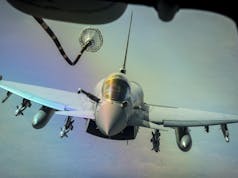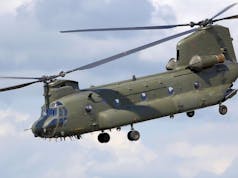Reports suggest that only one of the six E-3D Sentry AWACS fleet owned by the UK is available.
“The readiness and number of flying hours completed by aircraft have been reducing, and the Committee has heard anecdotal evidence that only one of the six E-3D aircraft is available for service at any one time,” the Defence Committee claim.
The Committee went on to say:
“The 2015 SDSR committed the RAF to keeping the fleet in service until 2035, but the E-3D aircraft are no longer maintained and upgraded to the required avionics standards, and flying hours in recent years have been substantially reduced.
AWACS provide airborne surveillance and battle management capability over extended range, crucial in a complex airspace contested by peer adversaries. Recent reports indicate that a replacement for Sentry is being considered as part of the MDP.”
In response, Mark Lancaster, Minister of State (MoD) said:
“The RAF has sufficient Sentry aircraft to meet its current defence commitments.”
AWACS provide airborne surveillance and battle management capability over extended range, crucial in a complex airspace contested by peer adversaries. Recent reports indicate that a replacement for Sentry is being considered as part of the MDP.
The Ministry of Defence’s Modernising Defence Programme (MDP) must address the challenges presented by the resurgence of state-based threats and be supported by a fully-funded and sustainable financial settlement, says a report published by the Defence Committee. The report, entitled Beyond 2 per cent, has been produced ahead of the anticipated release of ‘high-level findings’ by the MDP, towards the end of June. It examines how the process has proceeded and highlights areas, including capability, commercial practices, recruitment and international partnerships, which the Committee expects the review to consider.
Options for the future delivery of the UK’s Airborne Warning and Control capability are being explored, with the focus now on replacing the E-3D Sentry fleet. We understand that upgrades however are reportedly considered to be expensive. According to Janes here, maintenance is becoming increasingly costly and replacing them instead might be the most cost-effective option.
Guto Bebb, Parliamentary Under-Secretary of State for Defence, recently said:
“No decision has been made with regard to the future delivery of the UK’s Airborne Warning and Control capabilities, although a range of options are being explored.”
Some industry commentators are also arguing for a new aircraft type altogether. The large sums of money allocated to upgrading the E-3D fleet should be used to purchase a more advanced off-the-shelf aircraft, a defence analyst has argued. Justin Bronk, Research Fellow, Airpower and Technology, outlines options for replacing the E-3 fleet in his paper ‘The Future of Air C2 and AEW: E-3 Sentry, Threat Technologies and Future Replacement Options’:
“The RAF’s E-3Ds need a £2-billion CSP both to bring them to rough parity with current US and French standards by the mid-2020s and to stretch the fleet out to 2035 in the process. However, the E-3, even in modernised form, is no longer a cutting-edge ABM&S system in a world where proliferating long-range missile systems and emerging non-Western low-observable fighters can force it to stay hundreds of kilometres from contested airspace, placing a higher premium on BLOS communications capacity rather than onboard sensors.
Even when it is able to operate closer to the battlespace, the AN/APY-1/2 mechanically scanned radar array common to all E-3s has significant inherent limitations in terms of its ability to detect low-observable, very slow moving and hypersonic threats, unlike more modern AESA-equipped AWACS types already in service with the US Navy and various air forces around the world. An AESA-equipped ABM&S platform with improved communications node capabilities, based on a commercial-derivative airframe, seems a logical alternative option which could provide the RAF with a more capable and efficient alternative to extending the life of the E-3D over the next 20 years.
Such an approach would incur programmatic risk and acquisition and integration costs, but the MoD should examine and weigh these against the expensive work required to extend the E-3D with a view to ensuring the RAF has the best capability possible for the next two decades.”
The US designed E-3D Sentry AEW.Mk 1 is an airborne early warning (AEW) and command and control aircraft in British service, but what does that mean?
The Sentry monitors airspace to provide threat detection of adversary aircraft and situational awareness on friendly assets.
Information gathered by the Northrop Grumman APY-2 radar is processed by the mission crew and disseminated via a variety of data links and communication systems. Sentry also has the capability to detect ships, relaying information to maritime aircraft or allied vessels for further investigation. Its electronic support measures equipment enables the E-3D to gather emissions from other radar systems and emitters, enhancing the crew’s understanding of the environment in which it is operating.













MDP will be nothing more than another cuts exercise unless it increases numbers or balances reductions in some areas with equal expansion of others.
Yep. There’s a huge threat even in the name. “Modernisation” is a great setup line for deep cuts in whatever the authors deem to be “legacy” assets and capabilities.
Agree. There is the trap. The armed forces are modernised every time new kit replaces old a review is not needed for it. They used the modernisation line in 1995 Front Line First, they used it in 2004 Future Army Structures. A public not remotely interested cannot see through it I fear nor can ignorant journalists.
Three years ago a Capability manager in MOD told me it was impossible to upgrade the Sentry fleet. Something new was required. But the Service Chiefs are so cautious they won’t move. Caught like rabbits in headlights they know there’s no hope of upgrading and are petrified of buying something new without the US standing behind it. Too risk averse. Scared that the day they decide to join the Aussies in buying Wedgetail the yanks will finally announce to go in a different direction. I admire the Aussies in the way they’ve developed their defence capability recently.
Have to say am baffled by the defence ctte. On the one hand they say Sentry isn’t up to the job and then that we don’t have enough operational !
I think they took the attitude that something is better than nothing
Good Day!
What has and what is going on? Our Government and Labour to need to declare exactly what they intend to do to get out of this mess!
A very sad state of affairs and one of many!
As I mentioned in other posts the Chamberlin scenario seems to be repeating itself! Do something Mrs May! Before it’s too late!
Interesting:
UK committee urges against Wedgetail selection
The chairman of the UK’s cross-party parliamentary Defence Committee has taken the unusual step of making public its concerns over a possible plan to replace the Royal Air Force’s fleet of Boeing E-3D Sentry airborne warning and control system aircraft.
On 3 July, the committee published a letter sent by MP Dr Julian Lewis to minister for defence procurement Guto Bebb on 26 June, referencing “recent reports concerning the potential replacement of the Royal Air Force’s E-3D Sentry AWACS aircraft, and in particular the suggestion that a decision on a replacement system may be taken without a competitive tender in favour of the Boeing E-7 Wedgetail aircraft”.
“In the light of the convincing evidence we have received of at least one highly credible alternative to the Wedgetail, we can see absolutely no reason to dispense with an open competition,” the correspondence notes.
While the committee does not identify any other potential systems, a likely candidate could be Saab’s GlobalEye development of the Bombardier Global 6000 business jet, which is now in development for launch customer the United Arab Emirates.
The committee also voices concern over the poor state of the RAF’s existing AWACS assets, citing “a continuing decline in the availability, readiness and number of flying hours completed by the aircraft”.
It cites anecdotal evidence pointing to “a poor state of maintenance… [with] only one of the six aircraft in the fleet available for frontline service at any one time”. It also notes: “The poor maintenance and support of this capability over a number of years is greatly to be regretted.”
Lewis also used the letter to raise objections over placing a major order with the US manufacturer at this time. “It would be particularly inappropriate for a competition to be foregone in favour of Boeing, following their involvement in the imposition of punitive tariffs against Bombardier last year. At the time, the then defence secretary indicated that Boeing’s behaviour would put their ability to secure future defence deals at risk.”
https://www.flightglobal.com/news/articles/uk-committee-urges-against-wedgetail-selection-449948/
Select Committee not warning against Wedgetail but rather warning against single source purchase suggesting procurement should be competed instead. Suspect there is some lobbying going on in there. Only alternative is SAAB Erieye. In my book Wedgetail is better and we shouldn’t waste time competing. Just do it! But what do I know?
Boeing have just bought 80% of Embraer. Not sure on Boeing’s justification for having the fine imposed on Bombardier, as at the time they had no competitive aircraft. As if by magic they buy the majority share in a regional jet manufacturer who is a direct competitor to Bombardier. This smacks of the same posturing that Lockheed did to ensure Europe bought the F104 starfighter ie using the political system to meet their own needs.
I like the Saab Globaleye but I don’t think it’s as good as the Wedgetail. Yes they both use AESA radars but the Globaleye only has transceiver modules down the two sides of the above cabin “canoe”. This means that there are 60 degree gaps to the front and rear of the aircraft. The Wedgetail by comparison has additional transceiver modules in the nose and tail of its canoe to fill the coverage gap.
The Globaleye has a maritime surveillance radar mounted under the fuselage which probably has a 360 view, not sure it will be sufficient for aerial target searching though.
I don’t think the Airforce will consider anything too radical like the Airlander AEW concept, but it would be interesting to see what it could do.
And there maybe 5-eyes equipment on board Wedgetail that neither SAAB or Airbus would not be allowed to have interface too.
Just how far run down do we need to get in our front line military capabilities before HMG starts to take it seriously? We’ve had decades of deliberately dropping our guard & one day an aggressor will take advantage of it as we sleepwalk through time. Just because the public aren’t concerned, or rather it’s not much on their radar(no pun intended), doesn’t mean HMG is not entirely responsable for defending it. Cleaver spin is of zero military value.
1/6 servicability is criminal
The money exists. Budgets for upgrade were earmarked in 2015 SDSR. It’s not HMG stopping it. It’s the blooming Air Marshals sitting on their fat backsides. A requirement has to be endorsed, monies earmarked for upgrade transferred over to procurement and DE&S told to get on with it. Simples…
The UK RAF FAA and lets say a Coastal Command require several different types of aircraft in the future and that is the near future. The first is a Sentry replacement, then a ELINT replacement, a maritime/anti sub patrol, and what I would call a command and control aircraft. Requirements as in numbers is difficult for me to address but I will use these figures, Sentry replacement would need to be nine aircraft, preferably 12 as three could either be deployed in an emergency or be in the workshop for refits. Elint replacements six aircraft one attached to every two Sentries. Although we are buying nine Poseidon’s I don’t know if this is a good idea, but in reality we need a minimum of 15 aircraft to carry out this task. As for the Command and Control aircraft, this would collect all the information from the battlespace be that land sea and air and would be able to command the forces available in their allocated areas including nuclear strike. To achieve this a minimum of three aircraft would be needed.
So now we have the first problem, do we buy individual airframes and put the equipment inside or a single platform an put the equipment inside. For me that is a no brainer, a single air-frame for the ease of maintenance and spares. As we already have the Voyager this should be the air-frame to go for. That is a total of 36 airframes much of which is built in the UK so good for jobs and stops Airbus from leaving well makes them think again. Can this be done financially, I think so as long a politicians stop playing games, with a ten year project build it should work. There is no risk with airframe development we know it works, the electronic fits could be off the shelf from Sweden GlobalEye and the US anti submarine and command and control. Specialist UK equipment can be installed at home. All maintenance is to be carried out in the UK so if a company wants a part of the project then they set up workshops in the UK.
Although people will say that this is wishful thinking I think that most would agree with the requirements, some might say that a Sentry replacement can do the Maritime work, well not really, the environment is different to start with. A Sentry type aircraft is not designed to work alone but will have some combat aircraft with it. A maritime patrol/anti sub aircraft is a lone hunter that can if need be defend itself. As an air-frame they are also more expensive to build as they need to be navalised.
If we give a unit cost of £200 million all 36 aircraft would cost £720 million per year over the ten year procurement including equipment without weapons. I came to the 200 million as an average, Poseidon costs $150 mill fly away, GlobalEye $300 mill.
Do we have the money to spend on this I don’t know but if we can it would sure improve the security of the UK and the flexibility on the battlefield.
Must be the only one flying that’s just flown over London….